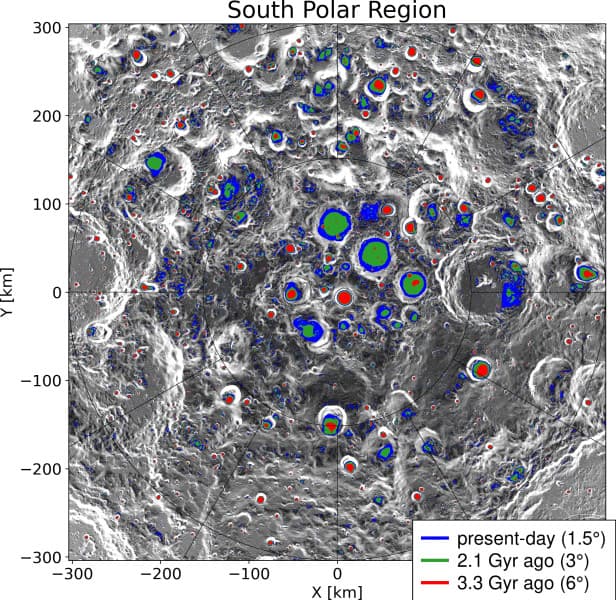Sept. 13, 2023, Tucson, Ariz. – Most of the Moon’s permanently shadowed areas arose less than 2.2 billion years ago and some trapped ice during the recent past, research led by Planetary Science Institute Senior Scientist Norbert Schorghofer shows.
“These findings change the prediction for where we would expect to find water ice on the Moon, and it dramatically changes estimates for how much water ice there is on the Moon. Ancient water ice reservoirs are no longer expected,” said Schorghofer, lead author of “Past Extent of Lunar Permanently Shadowed Areas” that appears in Science Advances.
Lunar water ice is a component integral to missions to the Moon, both to maintain human life and for producing fuel for spacecraft. Permanently shadowed regions (PSRs) are thought to have trapped ices and are a main focus of lunar exploration.
The Moon steadily migrates away from Earth, and it feels tidal forces from both the Earth and the Sun. It was known for decades that the Moon experienced a major spin axis reorientation at some point in the deep past, but there wasn’t enough data to really know when. It was only last year that a group in France came up with a coherent history for the evolution of the Earth-Moon distance. “When I heard about their result, I immediately realized it has profound implications for the search of water ice on the Moon. I dropped everything I was doing and began to work out the specifics, with the help of my co-author Raluca Rufu,” Schorghofer said.
“We calculated the lunar spin axis orientation and the extent of PSRs based on recent advances for the time evolution of the Earth-Moon distance,” he said. Early in its history, the Moon (which is 4.5 billion years old) was bombarded by comets and volcanism released water vapor from its interior, but continuously shadowed areas started to appear only 3.4 billion years ago. By that time these processes had started to die down, so most of the water that was delivered to the Moon or outgassed from its interior could not have been trapped in the polar regions. Any ice in the polar regions today must have a more recent origin.
“We have been able to quantify how young the lunar PSRs really are,” Schorghofer said. “The average age of PSRs is 1.8 billion years, at most. There are no ancient reservoirs of water ice on the Moon.”
The impact site of the Lunar Crater Observation and Sensing Satellite, a robotic spacecraft that detected water in 2009, lies within a PSR that is less than 1 billion years old, and therefore all the volatiles discovered there – which include water and carbon dioxide – must be young, he said. In a way this is very encouraging, because even the young PSRs contain ice. Older PSRs should contain even more ice.
This work might also explain why the polar regions of planet Mercury have much more ice than the Moon’s. Mercury’s PSRs are much older and could have captured water early on.
Schorghofer’s work was supported by a grant to PSI from the NASA issued Lunar Data Analysis Program (80NSSC22K1339) and by a subaward from the University of Maryland for the NASA Solar System Exploration Research Virtual Institute (SSERVI) node GEODES.
MEDIA CONTACT:
Alan Fischer
Public Information Officer
520-382-0411
[email protected]
SCIENCE CONTACT:
Norbert Schorghofer
Senior Scientist
[email protected]
PSI INFORMATION
Mark V. Sykes
Director
520-622-6300
[email protected]
PSI HOMEPAGE
PSI PRESS RELEASES
http://www.psi.edu/news/press-releases
THE PLANETARY SCIENCE INSTITUTE:
The Planetary Science Institute is a private, nonprofit 501(c)(3) corporation dedicated to Solar System exploration. It is headquartered in Tucson, Arizona, where it was founded in 1972.
PSI scientists are involved in numerous NASA and international missions, the study of Mars and other planets, the Moon, asteroids, comets, interplanetary dust, impact physics, the origin of the Solar System, extra-solar planet formation, dynamics, the rise of life, and other areas of research. They conduct fieldwork on all continents around the world. They also are actively involved in science education and public outreach through school programs, children’s books, popular science books and art.
PSI scientists are based in 30 states and the District of Columbia.
###

